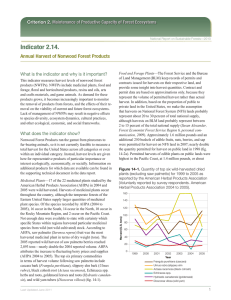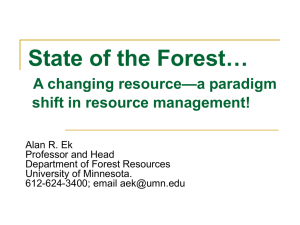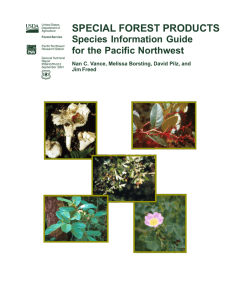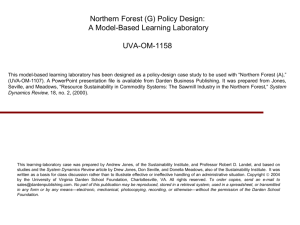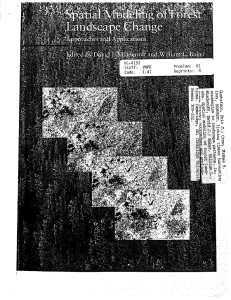Some Thoughts on Applied Research Designs
advertisement
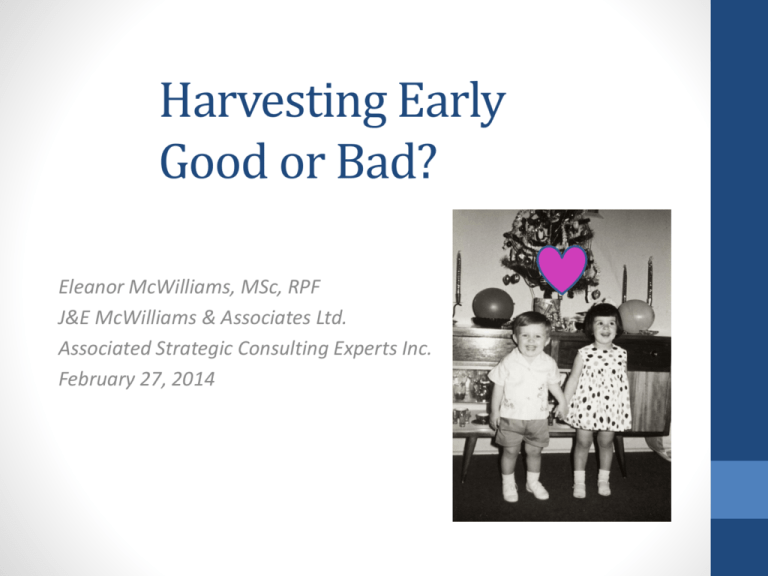
Harvesting Early Good or Bad? Eleanor McWilliams, MSc, RPF J&E McWilliams & Associates Ltd. Associated Strategic Consulting Experts Inc. February 27, 2014 It depends on… • • • • • • • • Objectives Timber supply constraints Market conditions Age class distribution Species composition Climate change strategies Accuracy of managed stand yield projections … Climate Change… 14,000,000 AAC 12,000,000 Forecasted Harvest (m3/yr) 10,000,000 8,000,000 6,000,000 Base case 4,000,000 Lower Minimum Harvest Criteria 2,000,000 0 0 50 100 Years from now 150 200 250 Managed Stand Growth • With the harvest history on the coast and the MPB infestation in the interior, timber supply forecasting is increasingly sensitive to estimates of current and future managed stand growth. • This in turn has focused the spotlight on the details of predicting managed stand growth. For example: • Early height growth • OAFs • Forest health impacts Early height growth • Improvements are required to: • Resolve inconsistent joins between height growth above and below breast height. • Provide models users the ability to input local height growth information. Early Height Growth 0.5 Height growth m/year Lodgepole SI 20 0.4 0.3 0.2 0.1 0 0 2 4 6 8 10 Total Age 12 14 Years to Breast Height • Intent is to allow users to directly enter years to breast height if local information is known. • Currently can get at this in TIPSY by “playing” with the stock height option, but this is clumsy and potentially misleading. • Adjustments have been made to site index functions to allow the input of fractional years to breast height (e.g. 4.2). • In the future, surveys could include a measurement of where 1.3 m falls between whorls. OAFs • Used to net down the potential yields predicted by TASS/TIPSY • TASS/TIPSY predict regular (self-thinning) mortality, not irregular mortality due to pests or abiotic damage. • Special runs can be done to mimic pests or abiotic damage and some disease modules have been developed (e.g. Rotsim). • Default OAF values come from comparison of research plot data to inventory data. • Default OAF values were chosen to get best estimates of yields at rotation. OAFs 1000 Merchantable Volume 900 800 700 600 500 100/100 400 50/100 300 100/50 200 100 0 15 20 25 30 35 40 45 50 55 60 65 70 75 80 85 90 95 100 Age Monitoring Required • We need better (in many cases any!) information on how our regenerated stands are actually growing. • Need it to adjust our predictions and fine tune our understanding of stand development to improve management for timber production and other values. • Options include: • Mid-rotation surveys • Network of permanent plots • In the ideal world, both. Why monitoring is required • • • • • • • • • • • To demonstrate sustainability and fulfill responsibilities To provide critical information for AAC determinations To check site productivity estimates To provide forest health incident and impact information To continually improve basic silviculture To provide feedback on stocking standards To ensure wise investments in incremental silviculture To ensure projected gains from tree improvement are realized To provide baseline data for climate change studies To ensure accurate carbon accounting To realize the full value from our research Monitoring in other Jurisdictions • USDA Forest Inventory & Analysis program maintains an approximately 5 km grid across forest land in the U.S. (both private and public). • Approximately 125,000 PSPs, of which 20% are measured each year. • If BC was to become a US State, assuming about 2/3 of BC is forested, USDA FIA would establish about 25,000 PSPs across the province. • If we adopted the Swedish model we would establish about 10,000 PSP on a grid across the province. Most forest management decisions, including when to harvest, are based in part on assumptions of future stand growth.





